
December 10-11
Adobe After Effects provides a comprehensive set of 2D and 3D tools for compositing, animation, and effects that motion-graphics professionals, visual effects artists, web designers, and film / video professionals need. AbstractPrerequisites: Basic computing skills: copying/pasting, right-clicking (contextual menus), finding files, switching between programs, exploring windows
After Effects is widely used for digital post-production of film, video, and the web. You can composite layers in various ways, apply and combine sophisticated visual and audio effects, and animate both objects and effects.
Topics covered include:
Getting comfortable with the Workflow
- Create a project and import footage
- Create a composition with layers
- Add effects and modify an individual layer's properties
- Preview your work
- Optimize work speed and system performance in After Effects
Creating Animations Using Effects and Presets
- Use Adobe Bridge to import footage
- Create a new composition
- Work with layers imported from Illustrator
- Apply effects to individual or multiple layers
- Apply presets to make animations easier
- Preview the effects you've just added
- Work with transparency
Animating Text
- Learn about text layers
- Create and format point text
- Use scale keyframes
- Use parenting in animations
- Adjust text opacity during animations
- Animate a non-text layer along a motion path
- Add motion blur to your composition
Working with Shape Layers
- Add in a shape layer
- Create your own custom shapes
- Incorporate video and audio layers
- Add a title bar
Rendering and Outputting
- Getting started
- Creating templates for the Render Queue
- About compression
- Exporting using the Render Queue
- Preparing movies for mobile devices
- Rendering movies with Adobe Media Encoder
- Preparing a movie for broadcast output
